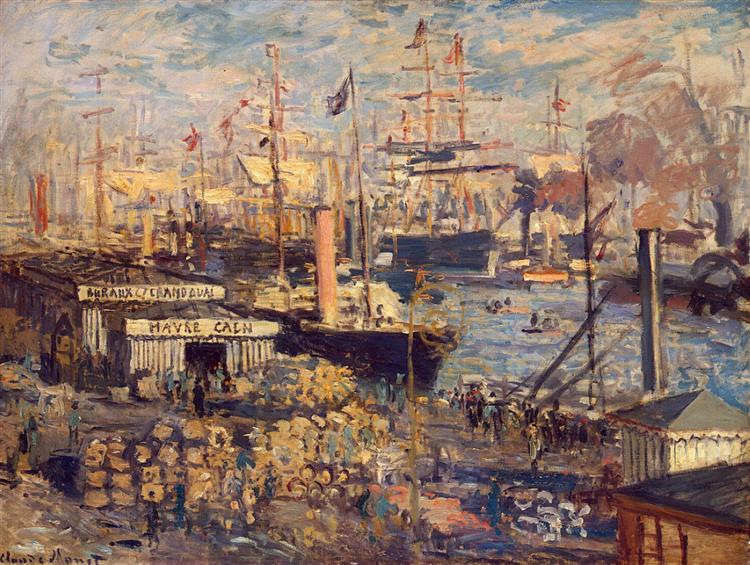Beskrivelse
Claude Monet's painting The Grand Quay at Le Havre (1872) is a brilliant example of the Impressionist style that the artist masterfully cultivated, using light and color as tools to capture fleeting moments of reality. In this painting, Monet delves into a port setting, a recurring theme in his work that reflects not only his fascination with contemporary life, but also his interest in atmospheric effects on the landscape and water. The composition is dominated by a panorama of the quay, where anchored boats can be seen, a landscape that becomes a breeding ground for the study of reflections and color interactions.
The dock structures are rendered in a palette that moves between greys and blues, accentuating the serenity of the moment. This choice of colours, which echoes the tones of the water and the sky, contributes to the feeling of depth and movement. The subtle nuances and bright splashes of colour that Monet applies create a vibrant visual effect, making the shadows and lights of the marine environment feel almost palpable. This is a distinctive feature of his technique, where the dynamic and rapid brushstrokes help to build a landscape that seems to come to life.
The figures are sparse in this work, which is typical of Monet's style in this period. Rather than focusing on the human figure, the artist directs our attention to the interaction of nature and the port architecture. In "The Grand Quay at Le Havre," the absence of prominent figures allows the viewer to focus on the surroundings, evoking a contemplative experience that invites reflection on the landscape and modern man. Additionally, this choice can be seen as a statement about the relationship between humans and the emerging industrial environment of the time.
An interesting aspect of the painting is how Monet, by capturing port life at a specific time, also inscribes his work in the historical context of the industrial revolution in France. Le Havre, as one of the most important ports in the country, was experiencing a significant flourishing in terms of trade and construction. This painting not only documents a place, but also acts as a visual testimony to the economic and social changes of its time.
“The Grand Quay at Le Havre” can be compared to other contemporary works by Monet, such as “Impression, Sunrise,” which also explores the interplay of light and water. However, this work is distinguished by its focus on a specific scene, capturing the dynamism and modernity of the port environment with a clarity and energy that are characteristic of the Impressionist movement. Monet, through his consistent exploration of light, color, and ephemeral moments, offers us a vision of the world that, while rooted in its time, continues to resonate with the contemporary viewer.
Ultimately, The Grand Quay at Le Havre is a testament to Monet's mastery of the Impressionist technique and his ability to transform everyday scenes into works of art in which light, color and landscape intertwine to tell a deeper story about the relationship between man and his environment. This work stands out not only for its visual beauty, but also for its cultural and historical significance, which continues to be the subject of study and admiration in the contemporary art scene.
KUADROS ©, a famous painting on your wall.
Hand-made oil painting reproductions, with the quality of professional artists and the distinctive seal of KUADROS ©.
Painting reproduction service with satisfaction guarantee. If you are not completely satisfied with the replica of your painting, we will refund 100% of your money.

